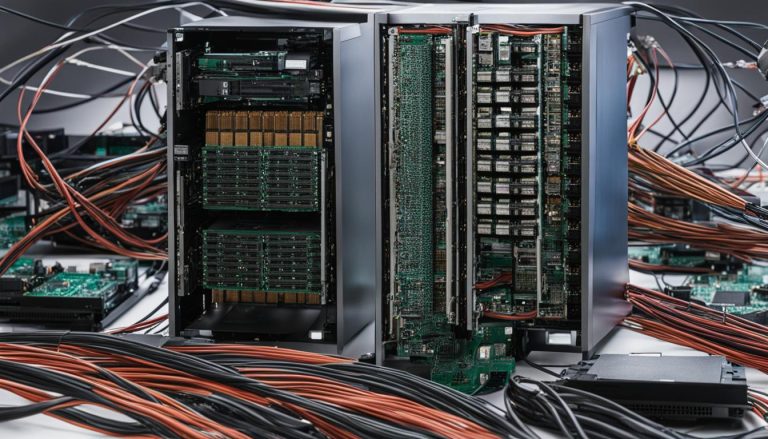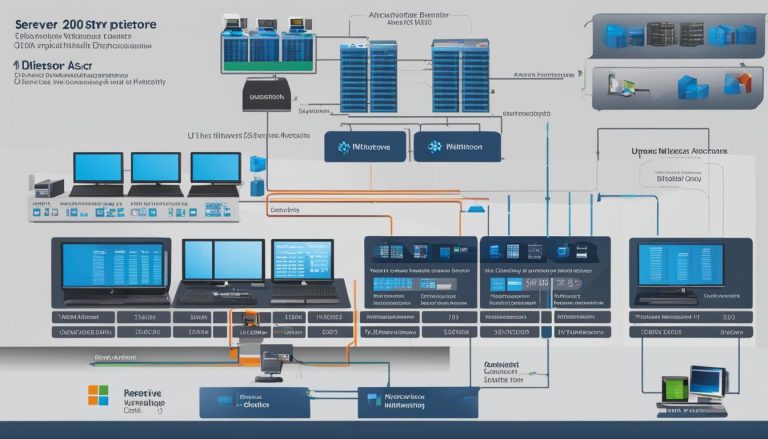Welcome to my comprehensive guide on Windows XP. In this article, I will provide you with a complete overview of what Windows XP is, its features, history, support, benefits, and more. Whether you’re a beginner or an experienced user, this guide will help you gain a deeper understanding of this popular operating system.
Key Takeaways:
- Windows XP is a major release of Microsoft’s Windows NT operating system.
- It combines features from both the home and corporate versions into a single operating system.
- Windows XP offers improved stability, security, and multimedia capabilities.
- There are two editions of Windows XP: Home Edition and Professional Edition.
- Understanding Windows XP is essential for efficient use of your computer.
What Windows Is—and What It Does
Windows XP is an operating system developed by Microsoft. It is the software that controls and manages the computer system, providing users with a graphical interface to interact with their devices. When you turn on your computer, Windows XP is what you see on your screen. It includes the desktop, taskbar, and Start menu, which are the main elements of the user interface.
Windows XP comes in different editions, with the two main versions being Windows XP Home Edition and Windows XP Professional Edition. The Home Edition is designed for home and small-business users, while the Professional Edition is tailored for larger businesses and corporate environments. Both editions offer a range of features and functionalities designed to enhance the user experience and improve productivity.
With Windows XP, users can perform a variety of tasks, such as running applications, managing files and folders, connecting to networks, and accessing the internet. It also provides multimedia capabilities, allowing users to play music and videos, view photos, and create presentations. The operating system is designed to be user-friendly, with intuitive controls and navigation options that make it easy for users to perform everyday tasks.
In summary, Windows XP is a powerful operating system that provides users with a comprehensive set of tools and features to effectively manage their computers. Whether you are a home user or a business professional, Windows XP offers a reliable and versatile platform that can meet your computing needs.
| Windows XP Features | Description |
|---|---|
| Stability | Windows XP offers greater stability compared to previous versions of Windows, reducing the likelihood of crashes and system errors. |
| Security | Windows XP includes enhanced security features to protect your computer from viruses, malware, and unauthorized access. |
| Compatibility | Windows XP is compatible with a wide range of hardware and software, ensuring that you can use your favorite applications and devices. |
| Multimedia Capabilities | Windows XP supports multimedia functions, allowing you to play music and videos, view photos, and create multimedia presentations. |
| User-Friendly Interface | Windows XP has a user-friendly interface with intuitive controls and navigation options that make it easy to use. |
Different Versions of Windows XP
Windows XP comes in several versions, each designed to meet the needs of different users. The two main editions are Windows XP Home Edition and Windows XP Professional Edition. These editions have the same core functionality, but the Professional Edition includes additional features aimed at larger corporate networks.
Windows XP Home Edition is intended for home and small-business users. It provides a user-friendly interface and includes features such as the ability to connect to the internet, create a home network, and easily share files and printers.
On the other hand, Windows XP Professional Edition is targeted at larger businesses and corporate users. It includes all the features available in the Home Edition, along with additional networking and security features for managing and protecting data on a corporate network.
| Windows XP Version | Target Users | Main Features |
|---|---|---|
| Windows XP Home Edition | Home and small-business users | User-friendly interface, internet connectivity, home networking, file and printer sharing |
| Windows XP Professional Edition | Larger businesses and corporate users | All Home Edition features, plus enhanced networking and security features |
| Windows XP Media Center Edition | Users interested in multimedia functions | Specialized interface for multimedia, remote control support |
In addition to the Home and Professional editions, there is also a version called Windows XP Media Center Edition. This version is designed for users who are interested in multimedia functionality. It includes a specialized interface for accessing and enjoying multimedia content, such as photos, videos, and music. Windows XP Media Center Edition also comes with a handheld remote control, allowing users to easily navigate and control their multimedia experience.
Working Your Way Around the Desktop
The Windows XP desktop is the visual interface that users interact with when they start their computer. It consists of various elements that help users navigate and access their files, programs, and settings.
One of the key components of the Windows XP desktop is the Start menu. Located in the bottom left corner of the screen, the Start menu provides access to all installed programs, documents, and system settings. By clicking on the Start button, users can open the Start menu and easily launch their favorite applications or search for files.
Another important part of the desktop is the taskbar, which is typically located at the bottom of the screen. The taskbar displays buttons for open applications, allowing users to quickly switch between different programs. It also includes the system tray, which shows icons for system utilities and background processes.
On the desktop itself, users can place shortcut icons for their frequently used programs or files. These icons provide quick access to the associated items with a single click. Additionally, the desktop also houses the Recycle Bin, which is where deleted files are temporarily stored before being permanently deleted.
In summary, the Windows XP desktop is the central hub that allows users to access and manage their files, programs, and settings. Understanding the different components, such as the Start menu, taskbar, shortcut icons, and Recycle Bin, is essential for efficient use of the operating system.
Important Windows Operations
In order to effectively navigate and utilize the Windows XP operating system, it is essential to be familiar with several important operations. These operations include:
- Pointing and Clicking: This is the most common operation used to select objects on the screen. By positioning the cursor over an item and clicking the left mouse button, you can activate or interact with that particular object.
- Double-Clicking: Double-clicking is an operation used to activate a specific function or open a program or file. By quickly clicking the left mouse button twice in rapid succession, you can execute the desired action.
- Right-Clicking: Right-clicking involves clicking the right mouse button to open a context menu with a list of commands related to the selected object. This allows for convenient access to various options and settings.
- Dragging and Dropping: This operation involves clicking and holding the left mouse button while moving the cursor to drag an object from one location to another. This is useful for moving files, organizing folders, and rearranging items on the desktop.
- Hovering: Hovering refers to positioning the cursor over an object without clicking. This action often triggers additional information or options related to that object, providing users with valuable context-sensitive actions.
Mastering these operations will greatly enhance your ability to navigate and interact with Windows XP efficiently.
A solid understanding of these operations allows users to accomplish tasks more quickly and effectively, improving overall productivity and user experience.
By becoming proficient in pointing and clicking, double-clicking, right-clicking, dragging and dropping, and hovering, you gain greater control over the Windows XP operating system, unlocking its full potential.
Getting the Most out of Windows XP
Knowing these essential Windows XP operations is just the beginning. To truly maximize your experience with this operating system, consider exploring additional features and functionalities, such as keyboard shortcuts, customization options, and advanced settings. With a little practice and familiarity, you can become a Windows XP power user and accomplish your tasks with ease.
Conclusion
Summing up, Windows XP is a widely used operating system developed by Microsoft. It combines the best features of both home and corporate versions, making it a versatile and user-friendly platform. With its extensive functionality, Windows XP has had a significant impact on the computer industry, offering stability and compatibility.
Although support for Windows XP ended in 2014, it remains a popular choice among users. Its user-friendly interface and robust features have made it a trusted operating system. Understanding the key aspects of Windows XP is crucial for anyone using or working with computers.
In summary, Windows XP is an efficient and reliable operating system that has left a lasting mark in the world of computing. Its legacy lives on, and its impact on the industry is undeniable.
FAQ
What is Windows XP?
Windows XP is a major release of Microsoft’s Windows NT operating system that combines the features of both the home and corporate versions into a single operating system.
When was Windows XP released?
Windows XP was released on August 24, 2001.
What are the editions of Windows XP?
Windows XP comes in two editions: Windows XP Home Edition and Windows XP Professional Edition.
Who is Windows XP Home Edition for?
Windows XP Home Edition is for home and small-business users.
Who is Windows XP Professional Edition for?
Windows XP Professional Edition is for larger businesses and corporate users.
Are there any other versions of Windows XP?
Yes, there is also a version called Windows XP Media Center Edition, which includes a specialized interface for multimedia functions and comes with a handheld remote control.
What are the key elements of the Windows XP desktop?
The Windows XP desktop includes the Start button, taskbar, system tray, shortcut icons, and the Recycle Bin.
How do I navigate and use the elements on the Windows XP desktop?
To efficiently use Windows XP, you need to master operations such as pointing and clicking, double-clicking, right-clicking, dragging and dropping, and hovering.
What are some important Windows XP operations?
Important Windows XP operations include pointing and clicking to select objects, double-clicking to activate an operation, right-clicking to open a pop-up menu, dragging and dropping to move objects, and hovering for certain actions.
Is Windows XP still supported?
No, support for Windows XP ended in 2014.
Janina is a senior specialist in information technology


